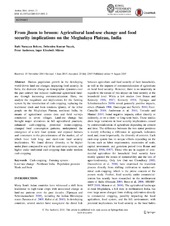From jhum to broom: Agricultural land-use change and food security implications on the Meghalaya Plateau, India
Peer reviewed, Journal article
Published version

Åpne
Permanent lenke
https://hdl.handle.net/1956/11626Utgivelsesdato
2016-02Metadata
Vis full innførselSamlinger
- Department of Geography [634]
Originalversjon
https://doi.org/10.1007/s13280-015-0691-3Sammendrag
Human population growth in the developing world drives land-use changes, impacting food security. In India, the dramatic change in demographic dynamics over the past century has reduced traditional agricultural land-use through increasing commercialization. Here, we analyze the magnitude and implications for the farming system by the introduction of cash-cropping, replacing the traditional slash and burn rotations (jhum), of the tribal people on the Meghalaya Plateau, northeast India, by means of agricultural census data and field surveys conducted in seven villages. Land-use change has brought major alterations in hill agricultural practices, enhanced cash-cropping, promoted mono-cropping, changed food consumption patterns, underpinned the emergence of a new food system, and exposed farmers and consumers to the precariousness of the market, all of which have both long- and short-term food security implications. We found dietary diversity to be higher under jhum compared to any of the cash-crop systems, and higher under traditional cash-cropping than under modern cash-cropping.
